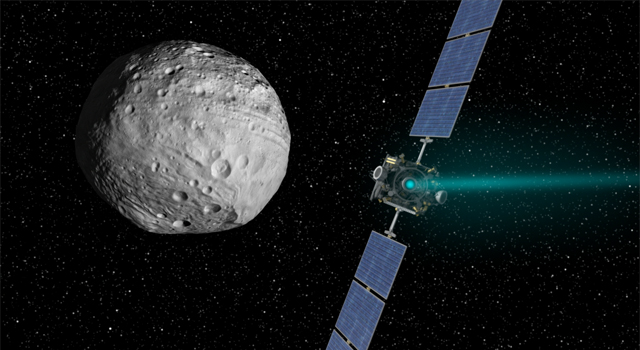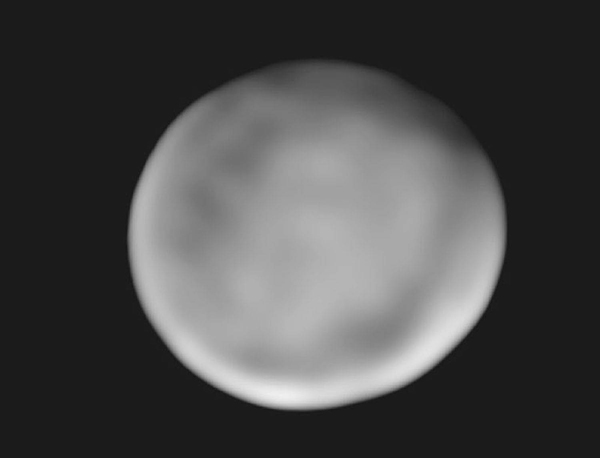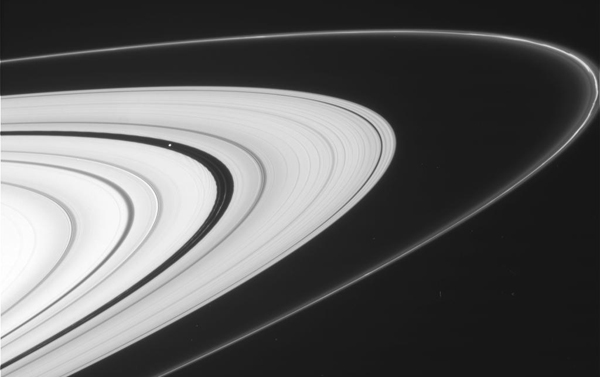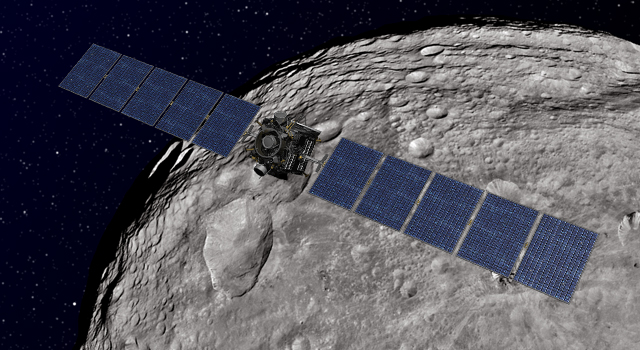The Giant Asteroid, Near and Far
Thursday, January 10th, 2013
As NASA’s Dawn spacecraft makes its journey to its second target, the dwarf planet Ceres, Marc Rayman, Dawn’s chief engineer, shares a monthly update on the mission’s progress.

Artist’s concept of NASA’s Dawn spacecraft departing the giant asteroid Vesta. Image credit: NASA/JPL-Caltech
Dawn concluded 2012 almost 13,000 times farther from Vesta than it began the year. At that time, it was in its lowest orbit, circling the alien world at an average altitude of only 210 kilometers (130 miles), scrutinizing the mysterious protoplanet to tease out its secrets about the dawn of the solar system.
To conduct its richly detailed exploration, Dawn spent nearly 14 months in orbit around Vesta, bound by the behemoth’s gravitational grip. In September they bid farewell, as the adventurer gently escaped from the long embrace and slipped back into orbit around the sun. The spaceship is on its own again in the main asteroid belt, its sights set on a 2015 rendezvous with dwarf planet Ceres. Its extensive ion thrusting is gradually enlarging its orbit and taking it ever farther from its erstwhile companion as their solar system paths diverge.
Meanwhile, on faraway Earth (and all the other locations throughout the cosmos where Dawnophiles reside), the trove of pictures and other precious measurements continue to be examined, analyzed, and admired by scientists and everyone else who yearns to glimpse distant celestial sights. And Earth itself, just as Vesta, Ceres, Dawn, and so many other members of the solar system family, continues to follow its own orbit around the sun.
Thanks to a coincidence of their independent trajectories, Earth and Dawn recently reached their smallest separation in well over a year, just as the tips of the hour hand and minute hand on a clock are relatively near every 65 minutes, 27 seconds. On Dec. 9, they were only 236 million kilometers (147 million miles) apart. Only? In human terms, this is not particularly close. Take a moment to let the immensity of their separation register. The International Space Station, for example, firmly in orbit around Earth, was 411 kilometers (255 miles) high that day, so our remote robotic explorer was 575 thousand times farther. If Earth were a soccer ball, the occupants of the orbiting outpost would have been a mere seven millimeters (less than a third of an inch) away. Our deep-space traveler would have been more than four kilometers (2.5 miles) from the ball. So although the planet and its extraterrestrial emissary were closer than usual, they were not in close proximity. Dawn remains extraordinarily far from all of its human friends and colleagues and the world they inhabit.
As the craft reshapes its solar orbit to match Ceres’s, it will wind up farther from the sun than it was while at Vesta. (As a reminder, see the table here that illustrates Dawn’s progress to each destination on its long interplanetary voyage.) We saw recently, however, that the route is complex, and the spacecraft is temporarily approaching the sun. Before the ship has had time to swing back out to a greater heliocentric range, Earth will have looped around again, and the two will briefly be even a little bit closer early in 2014. After that, however, they will never be so near each other again, as Dawn will climb higher and higher up the solar system hill, its quest for new and exciting knowledge of distant worlds taking it farther from the sun and hence from Earth.




























